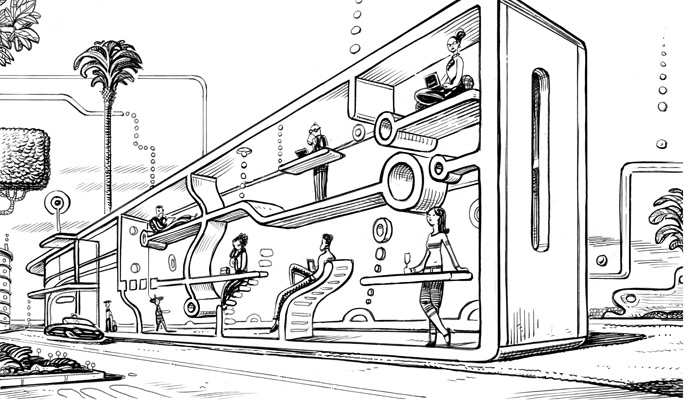Winning with Digital Confidence
The right mix of talent, innovation, and experience will help your company master emerging technology.
Today, if there’s a problem with the heat or hot water in your hotel room, you call the front desk and wait for maintenance to arrive. At some chains, you have the option of reporting the issue using a mobile device. But in the near future, many hotel rooms will be wired with connected devices that report potential breakdowns to maintenance and may even automatically fix them. Smart-building technology will turn the heat up when your app’s locator notices you are on the way back to your room.
Of course, such developments have significant implications for hotel staff. George Corbin thinks about them from a scientific perspective. As the senior vice president of digital at Marriott, Corbin oversees Marriott.com and Marriott mobile, and is responsible for about US$13 billion of the company’s annual revenue. He notes that the “skills half-life” of a hotel industry worker is about 12 years, at least for those working in conventional areas such as sales, operations, and finance. In other words, if people leave jobs in these functions, they could come back in 12 years and half their skills would still be relevant. But on the digital side, the skills half-life shrinks to a mere 18 months, according to Corbin.
Virtually every other industry faces similar dynamics. Digital competency is practically mandatory in many sectors; if you don’t get on board, you’ll fall behind competitors that do. And yet the knowledge required for widespread digital competency is often in short supply, and the related skills in agility and collaboration are often difficult to achieve in large companies. In a few years, an 18-month skills half-life may seem like a luxury. As a result, many executives’ confidence in their organization’s “Digital IQ” — their ability to harness digital-driven change to unlock value — is at an all-time low.
That’s one of the main findings from the 2017 edition of PwC’s Digital IQ survey. We interviewed more than 2,200 executives from 53 countries whose companies had annual revenues of at least $500 million, and found that executive confidence had dropped a stunning 15 percentage points from the year before. These company leaders said that they are no better equipped to handle the changes coming their way today than they were in 2007, when we first conducted this survey.
Back in 2007, being a digital company was often seen as synonymous with using information technology. Today, digital has come to mean having an organizational mind-set that embraces constant innovation, flat decision making, and the integration of technology into all phases of the business. This is a laudable change; however, in many companies, workforce skills and organizational capabilities have not kept pace. As the definition of digital has grown more expansive, company leaders have recognized that there exists a gap between the digital ideal and their digital reality.
Company leaders have recognized a gap between the digital ideal and their digital reality.
The ideal is an organization in which everyone has bought into the digital agenda, and is capable of supporting it. What does this look like? It’s a company in which the workforce is tech fluent, with a culture that encourages the kind of collaboration that supports the adoption of digital initiatives. The organizational structure and systems enable leaders to make discerning choices about where to invest in new technologies. The company applies its talent and capabilities to create the best possible user experiences for all of its customers and employees.
Simply upgrading your IT won’t get you there. Instead of spending indiscriminately, start by identifying a tangible business goal that addresses a problem that cannot be addressed with existing technology or past techniques and then develop the talent, digital innovation capabilities, and user experience to solve it. These three areas are where the new demands of digital competence are most evident. They are all equally important; choosing to focus on just one or two won’t be enough.
Our findings from 10 years of survey data suggest that the organizations that can best unite talent, digital innovation capabilities, and user experience into a seamless, integrated whole have a higher Digital IQ, and are generally further along in their transformation. Our data also shows that the companies that use cross-functional teams and agile approaches, prioritize innovation with dedicated resources, and better understand human experience, among other practices, have financial performance superior to that of their peers. It’s time for company leaders to build their digital confidence and their digital acumen; they can’t afford to wait.
Getting Tech Savvy
“We are now moving into a world with this innovation explosion, where we need full-stack businesspeople,” says Vijay Sondhi, senior vice president of innovation and strategic partnerships at Visa, drawing an analogy to the so-called full-stack engineers who know technology at every level. “We need people who understand tech, who understand business, who understand strategy. Innovation is so broad-based and so well stitched together now that we’re being forced to become much better at multiple skill sets. That’s the only way we’re going to survive and thrive.”
In the past, digital talent could lie within the realm of specialists. Today, having a baseline of tech and design skills is a requirement for every employee. Yet overall digital skill levels have declined even further since our last report, published in 2015. Then, survey respondents said that skills in their organization were insufficient across a range of important areas, including cybersecurity and privacy, business development of new technologies, and user experience and human-centered design. In fact, lack of properly skilled teams was cited this year as the number one hurdle to achieving expected results from digital technology investments; 61 percent of respondents named it as an existing or emerging barrier. And 25 percent of respondents said they used external resources even when they had skilled workers in-house, because it was too difficult or too slow to work with internal teams.
Having a baseline of tech and design skills is a requirement of every employee.
The skills gap is significant, and closing it will require senior leaders to commit to widespread training. They need to teach employees the skills to harness technology, which may include, for example, a new customer platform or an artificial intelligence–supported initiative. They will also need to cross-train workers to be conversant in disciplines outside their own, as well as in skills that can support innovation and collaboration, such as agile approaches or design thinking. Digital change, says Marriott’s Corbin, is driven by using technology in ways that empower human moments. “Rather than replace [human interactions], we are actually finding it’s improving them. We need the human touch to be powered by digital.”
One way that companies can accomplish these goals is by creating a cross-discipline group of specialists located in close proximity (we refer to this as a sandbox), whether physically or virtually, so each can observe how the others work. Such teams encourage interaction, collaboration, freedom, and safety among a diverse group of individuals. Rather than working in isolation or only with peer groups, members develop a common working language that allows for the seamless collaboration and increased efficiency vital to moving at the speed of technology. And this approach avoids the typical workplace dysfunction that comes with breaking down silos: Because business issues are no longer isolated within one discipline, but rather intertwined across many, colleagues from disparate parts of the organization are able to better understand one another and collaborate to come up with creative solutions.
Part product development, part project management, the sandbox approach enables your workforce to visualize the journey from conception to prototype to revelation in one continuous image, helping spread innovation throughout the organization. The culture of collaboration can speed adoption of emerging technologies.
For example, this approach enabled the Make-A-Wish Foundation to bring employees together from across the organization, including some whose role in developing a new tech-based feature may not have been obvious, such as a tax expert and a lawyer. In just three months, using this approach, the foundation created and operationalized a crowdfunding platform to benefit sick children.
Investing in the Future
At GE Healthcare, engineers are experimenting with augmented reality and assistant avatars. “Part of my job is to help pull in [great innovations] and apply them through a smart architecture,” says Jon Zimmerman, GE Healthcare’s general manager of value-based care solutions. “The innovations must be mobile native, because…our job is to be able to serve people wherever they are. And that is going to include more and more sensors on bodies and, if you will, digital streaming, so people can be monitored just as well as a jet engine can be monitored.”
Amid an increasingly crowded field of emerging technologies, companies need strong digital innovation capabilities to guide their decision making. Yet this achievement often proves challenging as a result of organizational and financial constraints. Our survey revealed that fewer companies today have a team dedicated to exploring emerging technologies than was the case in years past. Many are relying on ad hoc teams or outsourcing. Moreover, 49 percent of companies surveyed said they still determine their adoption of new technologies by evaluating the latest available tools, rather than by evaluating how the technology can meet a specific human or business need.
Equally troubling, spending on emerging technologies is not much greater today, relative to overall digital technology budgets, than it was a decade ago. In 2007, the average investment in emerging technology was roughly 17 percent of technology budgets, a surprisingly robust figure at the time. Fast-forward 10 years, and that rate has grown to only about 18 percent, which may well be inadequate.
It’s time to change these trends. You’ve identified a problem that existing technology cannot solve, but you shouldn’t just throw money at every shiny new thing. A digital innovation capability must become a central feature of any transformation effort. This approach goes beyond simply evaluating what to buy or where to invest, to include how best to organize internal and external resources to find the emerging technologies that most closely match the direction and goals of the business.
A digital innovation capability must become a central feature of any transformation effort.
Nearly every company is experimenting with what we call the “essential eight” new technologies: the Internet of Things (IoT), artificial intelligence (AI), robotics, drones, 3D printing, augmented reality (AR), virtual reality (VR), and blockchain. The key is to have a dedicated in-house team with an accountable, systematic approach to determining which of these technologies is critical to evolving the business digitally and which ultimately will end up as distractions that provide little value to the overall operation. This approach should include establishing a formal listening framework, learning the true impact of bleeding-edge technologies, sharing results from pilots, and quickly scaling throughout the enterprise.
Perhaps most important, organizations need to have a certain tolerance for risk and failure when evaluating emerging technologies. Digital transformation requires organizations to be much more limber and rapid in their decision making. Says GE Healthcare’s Zimmerman, “One of our cultural pillars is to embrace constructive conflict. That means that when an organization transitions or transforms, things are going to be different tomorrow than they were yesterday. You must get comfortable with change and be open to the differing thoughts and diverse mind-sets that drive it.”
In a promising development, signs indicate that companies are starting to focus on bringing digital innovation capabilities in-house. According to the New York Times, investments by non-technology companies in technology startups grew to $125 billion in 2016, from just $20 billion five years ago. The Times, citing Bloomberg data, also noted that the number of technology companies sold to non-technology companies in 2016 surpassed intra-industry acquisitions for the first time since the Internet era began. Walmart, General Motors, Unilever, and others are among the non-technology giants that made startup acquisitions last year. General Electric, whose new tagline is “The digital company. That’s also an industrial company,” spent $1.4 billion in September 2016 buying two 3D printing businesses in Europe.
Other companies are engaging in innovative partnerships. In January 2017, at the annual Consumer Electronics Show, Visa, Honda, and IPS Group — a developer of Internet-enabled smart parking meters — teamed up to unveil a digital technology that lets drivers pay their parking meter tab via an app in the car’s dashboard. By “tokenizing” the car, or allowing it to provision and manage its own credit card credential, they essentially make it an IoT device on wheels. “The car becomes a payment device,” explains Visa’s Sondhi. “And taking it even further, we can turn it into a smart asset by publishing information that’s related to the car onto the blockchain. This can enable a whole host of tasks to be simplified and served up to the driver, such as pushing competitive insurance rates or automatically paying annual registration fees.”
Solving for “X”
At United Airlines, Ravi Simhambhatla, vice president of commercial technology and corporate systems, views digital innovation as a way to break free from habits ingrained in his company over nine decades because they are no longer relevant to its customers and employees. The company plans to use machine learning to create personalized experiences for its customers. For example, when someone books a flight to San Francisco, its algorithm will know if that person is a basketball fan and, if so, offer Golden State Warriors tickets. “What we have been doing is really looking at our customer and employee journeys with regard to the travel experience and figuring out how we can apply design thinking to those journeys,” says Simhambhatla. “And as we map out these journeys, we are focused on imagining how, if we had a clean slate, we would build them today.”
With the right digital skills and capabilities comes great opportunity to improve the experience of both your employees and your customers. One constant that emerges from 10 years of Digital IQ surveys is that companies that focus on creating better user experiences report stronger financial performance. But all too often, user experience is pushed to the back burner of digital priorities. Just 10 percent of respondents to this year’s survey ranked creating better customer experiences as their top priority, down from 25 percent a year ago. This imbalance between respondents’ focus on experience and its importance to both customers and employees has far-reaching effects. It creates problems in the marketplace, slows the assimilation of emerging technologies, and hinders the ability of organizations to anticipate and adapt to change.
Just 10 percent of respondents ranked creating better customer experiences as their top priority.
Part of the reason user experience ranks as such a low priority is the fact that CEOs and CIOs, the executives who most often drive digital transformation, are much less likely to be responsible for customer-facing services and applications than for digital strategy investments. As a result, they place a higher priority on revenue growth and increased profitability than on customer and employee experiences. However, user experience is also downgraded because getting it right is extremely difficult. It is expensive, outcome focused as opposed to deadline driven, and fraught with friction.
However, unlike so many other aspects of technological change, how organizations shape the human experience is completely within their control. Companies need to connect the technology they are seeking to deploy and the behavior change they are looking to create.
And making this connection will only become more critical as emerging technologies such as the IoT, AI, and VR grow to define the next decade of digital. These and other technologies that simultaneously embrace consumers, producers, and suppliers will amplify the impact of the distinct behaviors and expectations of these groups on an organization’s digital transformation.
Companies that focus too narrowly on small slivers of the customer experience will struggle to adapt, but overall experience-and-outcome companies that seamlessly handle multiple touch points across the customer journey will succeed. That’s because, when done right, the customer and employee experience translates great strategy, process, and technology into something that solves a human or business need. You have the skills and the capabilities; now you need to think creatively about how to use them to improve the user experience in practical yet unexpected ways. Says United’s Simhambhatla, “To me, Digital IQ is all about finding sustainable technology solutions to remove the stress from an experience. This hinges on timely and contextually relevant information and being able to use technology to surprise and delight our customers and, equally, our employees.”
The Human Touch
When talent, innovation, and experience come together, it changes the way your company operates. Your digital acumen informs what you do, and how you do it. For example, Visa realized back in 2014 that digital technology was changing not only its core business but also those of its partners so rapidly that it needed to bring its innovation capabilities in-house or risk being too dependent on external sources. It launched its first Innovation Center in 2014; the company now has eight such centers globally, and more are planned.
Visa’s Innovation Centers are designed as collaborative, co-creation facilities for the company and its clients. “The idea was that the pace of change was so fast that we couldn’t develop products and services in a vertically integrated silo. We want the Innovation Centers to be a place where our clients could come in, roll up their sleeves, work with us, and build solutions rapidly within our new, open network,” says Visa’s Sondhi. “The aim is to match the speed and simplicity of today’s social- and mobile-first worlds by ideating with clients to quickly deploy new products into the marketplace in weeks instead of months or quarters.”
Across industries, company leaders have clearly bought into the importance of digital transformation: Sixty-eight percent of our respondents said their CEO is a champion for digital, up from just one-third in 2007. That’s a positive development. But now executives need to move from being champions to leading a company of champions. Understanding what drives your customers’ and employees’ success and how your organization can apply digital technology to facilitate it with a flexible, sustainable approach to innovation will be the deeper meaning of Digital IQ in the next decade.
“It’s the blend that makes the magic,” says GE Healthcare’s Zimmerman. “It’s the high-impact technological innovations, plus the customer opportunities, plus the talent. You have to find a way to blend those things in a way that the markets can absorb, adopt, and gain value from in order to create a sustainable virtuous cycle.”
Reprint No. 17206
Author profiles:
- Chris Curran is a principal with PwC US based in the Dallas–Fort Worth area. He is the chief technologist for the firm’s new ventures practice, and he leads the development of PwC’s ongoing Digital IQ research.
- Tom Puthiyamadam is a principal with PwC US based in New York. He leads the firm’s digital services practice, which helps clients create next-generation experiences for their customers, employees, and partners. He is also the advisory markets and competencies leader.





